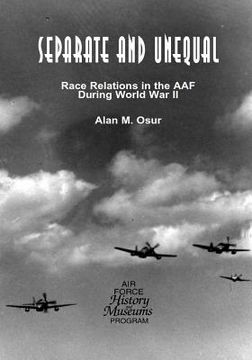Reseña del libro "Separate and Unequal: Race Relations in the AAF During World War II (en Inglés)"
Race relations between white and black Americans in the Army Air Forces (AAF) during World War II ran the gamut from harmonious to hostile, depending upon the unique circumstances existing within each unit, command, and theater. In analyzing racial policy as it was implementedthroughout the chain of command, are a number of themes relevant for an understanding of the utilization of African Americans during the war. First, the AAF never willingly accepted black soldiers. This service had totally excluded them for over two decades before they were permittedto enter, and then used them only reluctantly. The fact that the AAF even opened its doors to African Americans and proceeded to make additional opportunities available to them was due to pressures aimed at the War Department and the AAF. Individuals and organizations within the black community and white liberals in and out of Congress were quite vocal and were able to exert sufficient pressure to force the War Department and AAF to examine and modify their policies and practices throughout the war.Another recurring theme was that leadership within the War Department and AAF assumed that segregation was the most efficient system of race relations and accepted the "separate-but-equal" doctrine. Even if we accept "separate-but-equal" as the law of the land, the AAF did not, in fact, maintain equal facilities for black soldiers, and they were not afforded equal treatment. Thus, the policy of segregation was unsatisfactory for African Americans, and the duplicated facilities that were necessary to maintain the system were far too expensive in terms of the results obtained. And because of deeply ingrained racist beliefs, theAmerican public and the military were willing to accept the additional financial burden, social unrest, and inefficiency of segregation in an attempt to keep African Americans "in their place."During the war, the U.S. military inherited from American society and from its own traditions a difficult problem in attempting to absorb large numbers of African Americans into a war apparatus, and racial issues plagued the AAF. Although the AAF fervently defended segregation, its leaders failed to understand that this implied second-class citizenship for blacks. Additionally, blacks were no longer willing to accept the demeaning status to which they had been relegated, and using the military as a vehicle for their protests, voiced their objection to discriminatory treatment and segregation. Their protests were for military leaders a constant source of frustration and annoyance. However, one can discern a decided shift in the approach of the War Department in 1943. Until then, officials in the War Department and the AAF reflected society's traditional racist attitude toward the utilization of African Americans. The military did not consider black soldiers as part of the American military tradition and used them only when absolutely necessary for the defense of the country or when political pressure forced their use. With mounting pressure upon War Department officials, there was change in outlook from 1943 through the end of the war to recognizeand alleviate the race problem. The U.S. government sought to utilize black soldiers fairly rather than to view them merely as embarrassments and problems. Unfortunately, this change in attitude did not filter down through the AAF chain of command. Throughout the war, many AAF commanders demonstrated a reluctance to treat blacks with full equality and to show a sincere commitment to abide by positive War Department racial directives.

